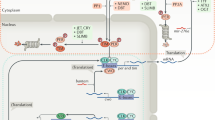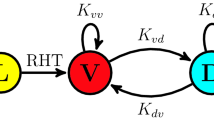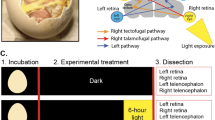Abstract
RHYTHMS of a circadian nature in locomotor and other kinds of activity have been described in a variety of organisms. While much is known about the time course and phase relations of such rhythms, very little is known about the internal regulating mechanisms. The diurnal locomotor rhythm in the cockroach is controlled by neurosecretory cells located in the sub-oesophageal ganglion1,2. Transplantation experiments have shown the importance of the presence of the sub-oesophageal neurosecretory apparatus for the persistence of the locomotory rhythm, but no variations with the time of the day in the direct effects of the neurosecretory products on the degree of activity of the central nervous system have been demonstrated.
This is a preview of subscription content, access via your institution
Access options
Subscribe to this journal
Receive 51 print issues and online access
$199.00 per year
only $3.90 per issue
Buy this article
- Purchase on Springer Link
- Instant access to full article PDF
Prices may be subject to local taxes which are calculated during checkout
Similar content being viewed by others
References
Harker, J. E., J. Exp. Biol., 33, 224 (1956).
Harker, J. E., J. Exp. Biol., 37, 164 (1960).
Rao, K. P., Proc. XVI Intern. Congr. Zool., 2, 69 (1963).
Ozbas, S., and Hodgson, E. S., Proc. U.S. Nat. Acad. Sci., 44, 825 (1958).
Milburn, N., Weiant, E. A., and Roeder, K. D., Biol. Bull., 118, 111 (1960).
Milburn, N., and Roeder, K. D., Gen. Comp. Endocrin., 2, 70 (1962).
Strejcková, A., Servit, Z., and Novák, V. J. A., J. Ins. Physiol., 11, 889 (1965).
Habibulla, M., thesis, Univ. Sri Venkateswara, Tirupati (1962).
Rao, K. P., J. Anim. Morphol. Physiol., 11, 133 (1964).
Author information
Authors and Affiliations
Rights and permissions
About this article
Cite this article
RAO, K., GROPALAKRISHNAREDDY, T. Blood Borne Factors in Circadian Rhythms of Activity. Nature 213, 1047–1048 (1967). https://doi.org/10.1038/2131047a0
Issue Date:
DOI: https://doi.org/10.1038/2131047a0
This article is cited by
-
Rest in the scorpion ? a sleep-like state?
Journal of Comparative Physiology A (1988)
-
Diurnal variations in physiological activities in the garden snail,Cryptozona ligulata
Journal of Comparative Physiology ? A (1978)
-
Circadian rhythmicity in phosphorylase activity and glycogen content in the heart muscle of the scorpion,Heterometrus fulvipes, C.L. Koch
Experientia (1978)
-
On the possible mode of action of neurohormones on cholinesterase activity in the ventral nerve cord of scorpion, Heterometrus fulvipes
Experientia (1977)
-
On the acetylcholine content in the scorpion,Heterometrus fulvipes C. Koch
Experientia (1975)
Comments
By submitting a comment you agree to abide by our Terms and Community Guidelines. If you find something abusive or that does not comply with our terms or guidelines please flag it as inappropriate.



